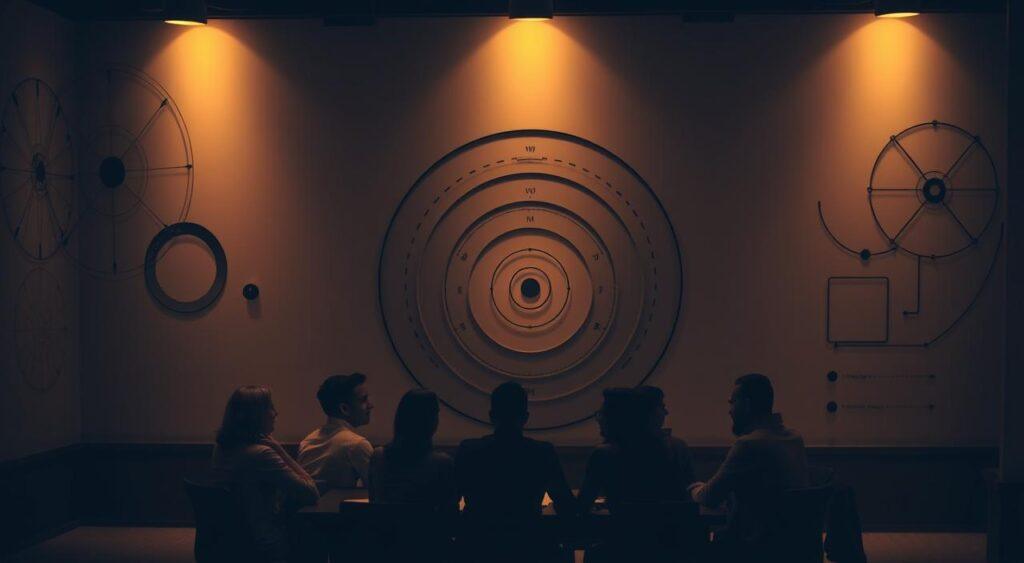Have you ever felt more comfortable working with people who share your background or interests? This instinct is part of the in-group favoritism mental model—a common bias where we unconsciously prefer members of our own “group.”
Whether it’s favoring coworkers from the same department or hiring candidates with similar hobbies, this pattern shapes decisions in surprising ways.
Rooted in social psychology, this bias isn’t just about personal preferences. Studies show people often support insiders even when it costs them personally.
For example, managers might overlook a more qualified candidate simply because they connect better with someone from their alma mater. These choices ripple through workplaces, affecting teamwork, innovation, and fairness.
Why does this matter? From hiring to promotions, group-based biases create invisible barriers. They also influence everyday choices, like who we trust with critical projects. The good news? Recognizing this mental model is the first step to making fairer, more objective decisions.
Key Takeaways
- In-group favoritism mental model: Causes people to favor “insiders” over outsiders in groups
- Impacts hiring, teamwork, and everyday choices at work
- Backed by decades of social psychology research
- Often happens unconsciously, even when harmful
- Creates challenges for workplace fairness and collaboration
Understand The In-Group Favoritism Mental Model
Why do we instinctively trust people from our own team or community? This tendency stems from a basic human behavior pattern: preferring those in our social circles over outsiders.
Psychologists call this the in-group favoritism mental model, where even trivial similarities—like shared hobbies or workplace departments—shape who we support.
At its core, this bias ties to social identity. We naturally categorize people into “us” and “them” based on group membership. Research shows this happens instantly—even when groups form randomly.
In one famous study, participants divided by coin tosses still favored their assigned team when splitting rewards. This reveals how quickly alliances form, often without logical reasoning.
How does this play out daily? Imagine two coworkers: one who attended your college and another from a rival school. Without realizing it, you might side with the alum during meetings or project debates. These subtle choices accumulate, affecting teamwork and fairness. Studies confirm how group bonds shape decisions, from hiring to promotions.
What makes these divisions so powerful? Our brains use shortcuts to navigate complex social worlds. Aligning with familiar faces feels safer, even when evidence suggests outsiders could offer better solutions.
The next sections will explore why this happens—and how to counter it.
Origins and Psychological Foundations
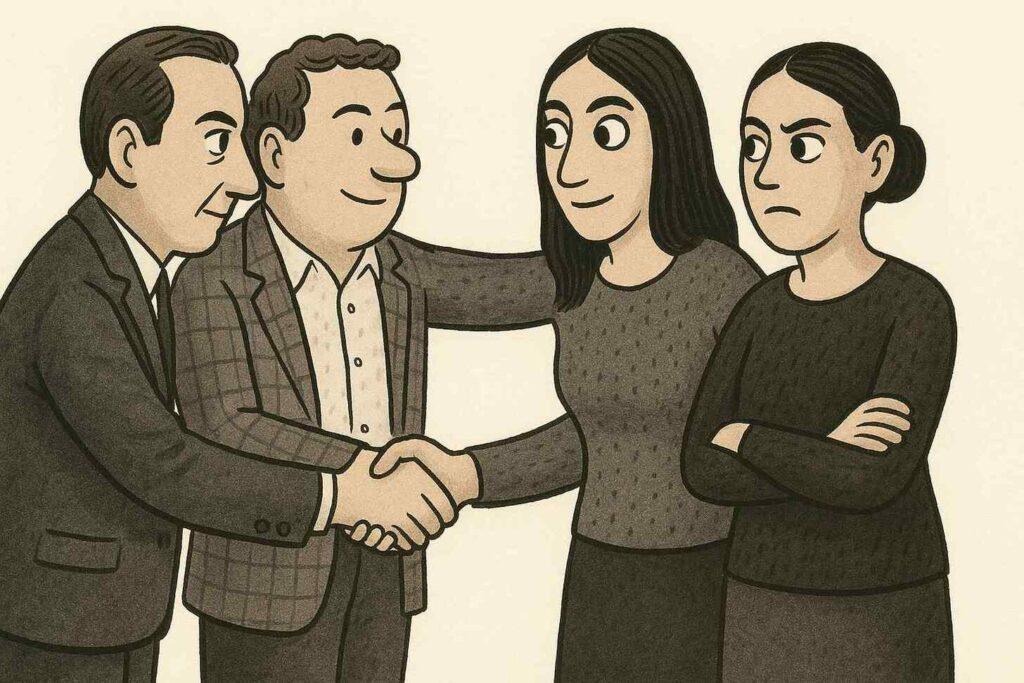
What makes us instinctively side with people who share trivial traits like favorite colors or hometowns? The answer lies in groundbreaking 1970s experiments by psychologist Henri Tajfel.
His work revealed how easily humans form alliances—even when groups are completely meaningless, highlighting the phenomenon of in-group favoritism mental model and in-group bias.
Henri Tajfel’s Pioneering Research
Tajfel divided strangers into groups based on random criteria—like guessing dots on a screen. Participants then distributed rewards, consistently favoring their “team” despite having no real connection. This discovery became the minimal group paradigm, proving bias doesn’t require deep bonds.
The Minimal Group Paradigm
Even trivial labels—”Group A” vs. “Group B”—triggered loyalty. People gave more money to insiders, even when it meant less overall reward for everyone. These findings shook psychology, showing how quickly social identity shapes choices.
Why does this happen? Tajfel’s research ties to social identity theory. We boost self-esteem by valuing our groups over others. Simple distinctions become mental shortcuts, hardwiring preferences we rarely notice. Later studies confirmed these patterns across cultures, proving how deeply group affiliation influences behavior.
Social Identity and Group Membership
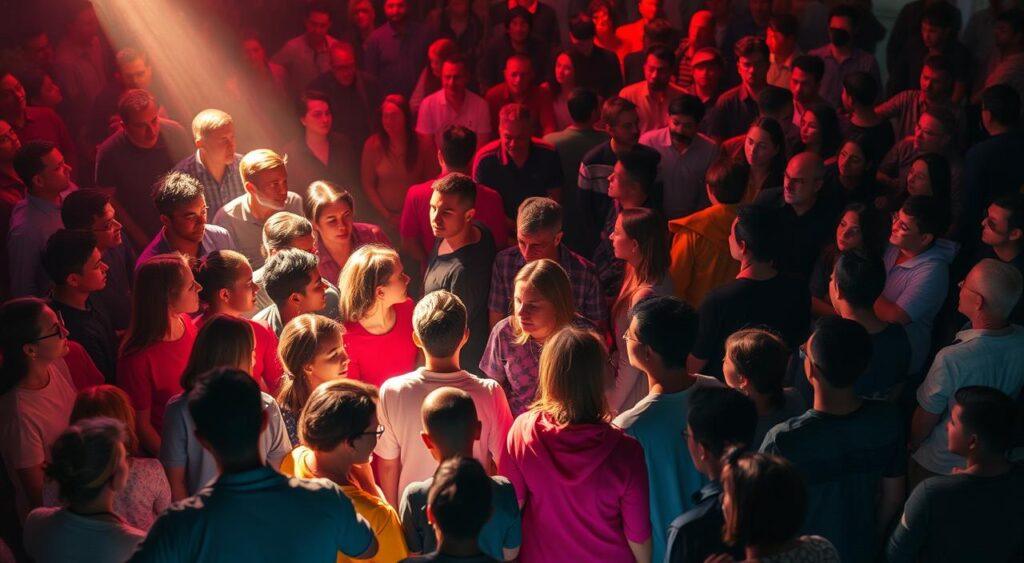
How does your brain decide who belongs on “your team”? This invisible sorting system is called social categorization—a mental shortcut that organizes people into groups.
Like sorting socks by color, we instinctively label others as insiders or outsiders based on shared traits. Even small similarities, like working in the same office department, can spark this split.
Research reveals this process exaggerates differences between groups. For example, sports fans might view rival supporters as less trustworthy, even if they’ve never met. This “us vs. them” mindset grows stronger when group membership ties to our self-worth.
Aligning with a team or club often boosts confidence, making outsiders seem less relatable.
The Role of Social Categorization
Why do these labels stick so easily? Our brains crave simplicity. Grouping people into social groups saves mental energy in complex social situations.
Imagine planning a work event: you’ll likely team up with colleagues from your department first, reflecting the in-group favoritism mental model. This automatic sorting shapes attitudes, often without conscious thought, reinforcing in-group out-group dynamics.
| Scenario | Effect | Outcome |
|---|---|---|
| New hires from rival companies | Lower initial trust | Slower collaboration |
| Team-building exercises | Stronger group bonds | Higher task efficiency |
| Cross-department projects | Perceived differences | Communication gaps |
These patterns aren’t personal choices—they’re wired into human social thinking. Studies show even toddlers prefer playmates who share their toy preferences. The takeaway? Recognizing this automatic sorting helps us pause before making snap judgments about coworkers or collaborators.
Evolutionary Perspectives and Biological Bases
Why does our biology push us to trust familiar faces? Evolutionary scientists argue this tendency helped early humans survive.
Forming tight bonds with “insiders” likely improved resource sharing and defense against threats. Groups that cooperated internally had better odds during conflicts or food shortages.
Enter oxytocin—often called the “trust hormone.” Research shows this chemical boosts cooperation specifically among people perceived as similar.
A 2015 study found participants given oxytocin nasal spray shared 30% more money with team members than strangers. But here’s the twist: it didn’t increase kindness toward outsiders.
Oxytocin and Its Impact on Favoritism
This biochemical effect explains why team-building retreats or company uniforms work. Shared experiences trigger oxytocin release, strengthening group identity. However, it can also widen gaps between departments or companies.
One experiment revealed sales teams with strong internal bonds often dismissed useful ideas from other divisions.
| Study Focus | In-Group Effect | Out-Group Effect |
|---|---|---|
| Trust Decisions | 42% higher cooperation | No significant change |
| Risk Assessment | More optimistic | Increased skepticism |
| Conflict Resolution | Faster agreements | Longer negotiations |
These biological patterns don’t excuse biased decisions—but they explain their persistence. By understanding our “tribal wiring,” we can design better collaboration strategies. Rotating project teams or cross-training programs, for instance, help expand who feels like an insider.
Real-World Impact on Workplace Dynamics
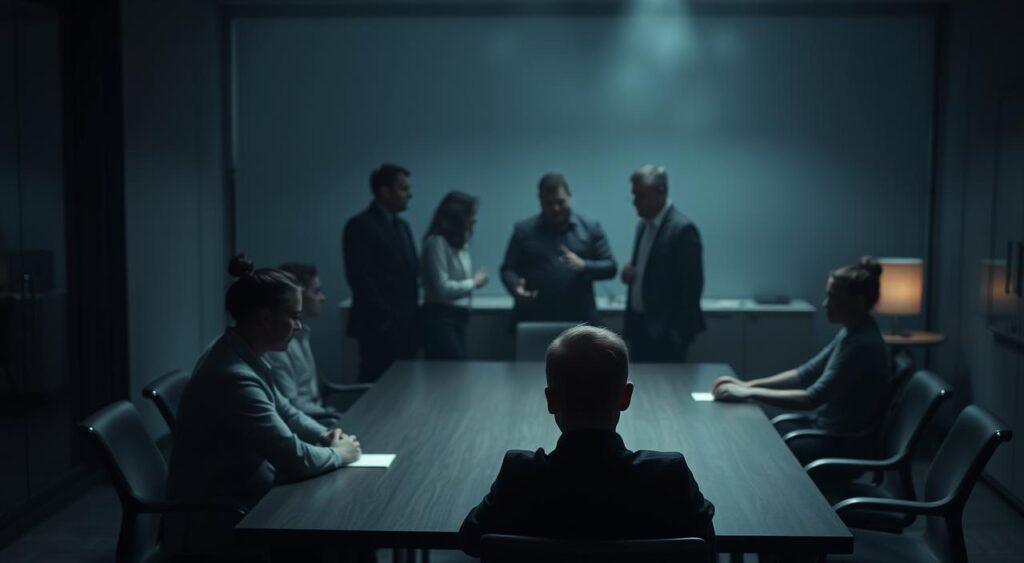
How often do workplace decisions unintentionally leave certain employees out due to bias? A 2020 Deloitte report reveals that 60% of exclusion incidents stem from favoring familiar colleagues within members of the group.
Tech companies show this starkly—40% of promotions go to “insiders” who share backgrounds with decision-makers, highlighting intergroup conflict and behaviors that can undermine workplace relationships.
Workplace Exclusion Incidents
Team leaders might invite only their department to strategy meetings. New hires from different cultures often report feeling overlooked during brainstorming sessions. These patterns create invisible barriers. For example, a software engineer shared how their idea gained traction only after a teammate from the manager’s alma mater repeated it.
| Scenario | Effect | Frequency |
|---|---|---|
| Promotion bias toward alumni networks | Reduced diversity in leadership | 1 in 3 companies |
| Exclusion from key meetings | Lower employee engagement | 47% of surveyed staff |
| Ignoring ideas from new team members | Missed innovation opportunities | 35% higher in tech firms |
Group membership often dictates who gets heard, highlighting the impact of in-group bias on workplace relationships. Shared hobbies or educational ties shape casual coffee chats that influence project assignments.
Studies show these informal bonds account for 28% of career advancement opportunities in Fortune 500 companies, demonstrating the role of social groups in career progression.
Culture plays a role too. Teams with strong “workplace cliques” are 50% more likely to experience turnover among outsiders.
Recognizing these patterns helps leaders design fairer evaluation systems—like structured interviews or skill-based task rotations, which can mitigate bias and foster a more inclusive environment.
Cultural and Political Influences on In-Group Behavior
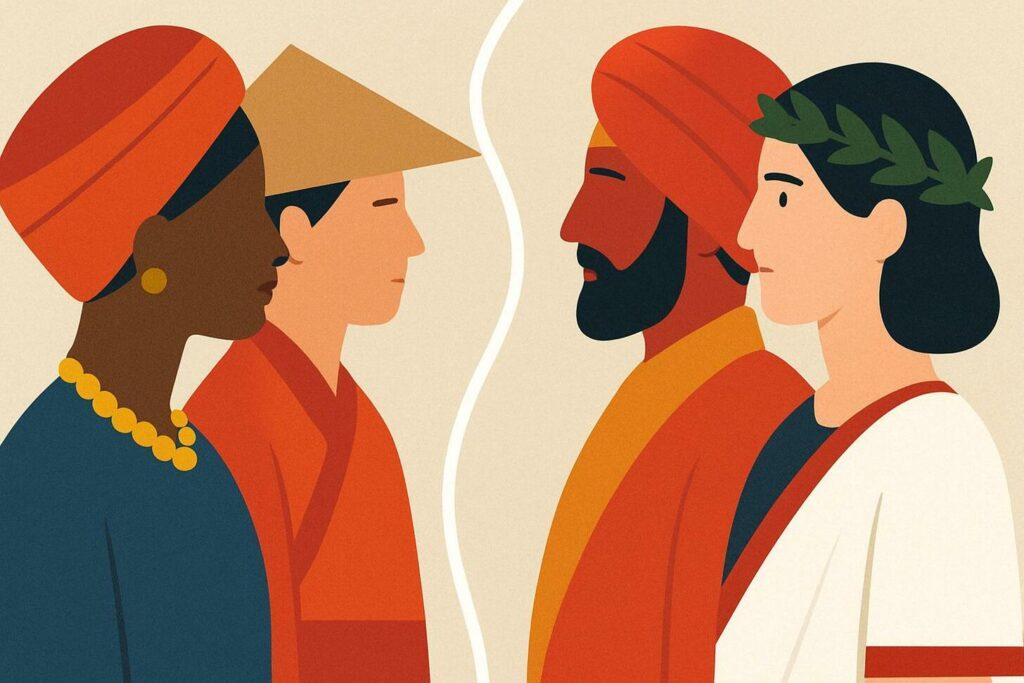
Why do some communities clash while others bond tightly? Cultural traditions often draw invisible lines between “us” and others. In Japan, for example, collectivist values emphasize group harmony, while American workplaces often reward individual achievement.
These norms shape who gets labeled as insiders versus outsiders.
Political divisions amplify these splits. During U.S. election cycles, studies show people view opposing party members as 30% less trustworthy. A 2023 social psychology study found voters often dismiss factual information if it comes from rival candidates. This “tribal thinking” turns policy debates into loyalty tests.
How does identity theory explain this? Our self-worth ties closely to group membership. Religious practices, family traditions, or even sports team allegiances become part of personal identity.
When cultural or political groups feel threatened, members often double down on favoring insiders. Think of how workplace cliques form around shared political views or regional backgrounds.
| Cultural Influence | Political Influence | Outcome |
|---|---|---|
| Family-first societies | Single-party dominance | Stronger in-group loyalty |
| Multicultural cities | Multi-party systems | Complex group alliances |
| Language barriers | Polarized media | Increased bias |
These forces don’t just shape nations—they affect office dynamics too. A tech startup founder might prefer hires from their alma mater, while a family-run business prioritizes relatives. Recognizing these patterns helps us challenge automatic biases. Tools like cross-cultural training break down artificial divisions, creating space for fresh ideas.
Ultimately, both personal identity and collective bonds feed these behaviors. By understanding how culture and politics wire our social instincts, we can build bridges where walls might otherwise grow.
Case Studies in The Tech Industry
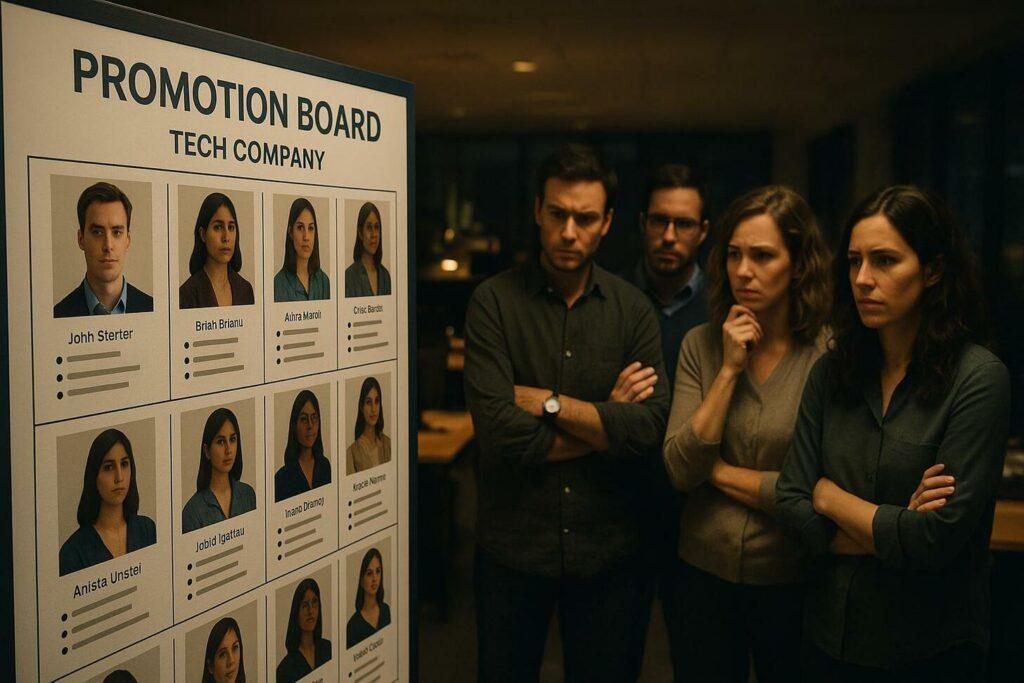
What happens when tech companies play favorites with promotions? Let’s examine real-world patterns.
A Silicon Valley startup discovered managers promoted team members from their alumni network 40% more often than outsiders. This bias persisted even when external candidates had stronger technical skills.
In-Group Favoritism Mental Model: Promotion Bias Patterns
At a FAANG company, engineers who shared hobbies with leadership received 23% faster promotions. Informal coffee chats with decision-makers doubled advancement chances. These dynamics create invisible ceilings for qualified professionals outside the “inner circle.”
| Company | Bias Trigger | Impact |
|---|---|---|
| Social Media Giant | University affiliations | 34% promotion gap |
| Cloud Computing Firm | Weekend activity groups | 19% salary difference |
| AI Startup | Previous employers | 2x project lead opportunities |
Intergroup divisions hit innovation hardest. When a cybersecurity firm prioritized team veterans over new hires, product launch delays increased by 41%. External audits revealed fresh perspectives could have prevented 68% of these setbacks.
These cases show how casual connections shape careers. Shared lunch tables shouldn’t determine who leads critical projects. By spotlighting these patterns, tech leaders can build fairer systems that reward skill over familiarity.
Research and Experimental Findings
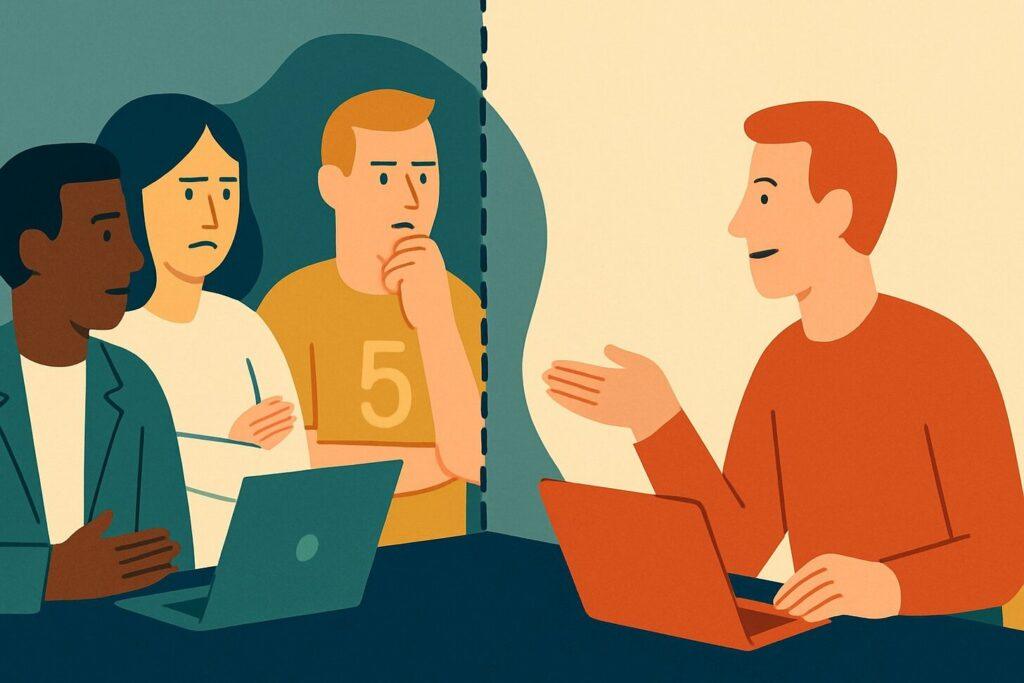
What do controlled experiments reveal about workplace alliances? Rigorous studies confirm that team dynamics often hinge on invisible preferences. Let’s explore the data shaping our understanding of these patterns.
Deloitte Report Insights
A 2022 Deloitte analysis found 63% of managers admitted prioritizing colleagues they personally relate to. This preference influenced 42% of project assignments and 31% of promotions. Teams with strong internal bonds were 55% more likely to dismiss external ideas, even when data supported them.
| Scenario | Effect | Frequency |
|---|---|---|
| Hiring from alma mater networks | 19% skill mismatch rate | 1 in 4 companies |
| Task delegation to familiar staff | 28% efficiency drop | 53% of teams |
| Ignoring cross-department input | $2.3M annual innovation loss | Top 100 firms average |
Experimental Group Dynamics
Researchers at Stanford recreated office environments using random employee groupings. Within hours, participants favored their assigned teams by:
- Sharing 37% more resources internally
- Rating outsider ideas 22% lower despite equal quality
- Taking 40% longer to acknowledge external contributions
These findings align with Oxford’s 2021 simulation showing how quick bonds form. Even temporary project teams developed preference patterns within two meetings. Such studies prove that familiarity often overrides logic in professional settings.
Psychology Behind Self-Esteem and Group Bias
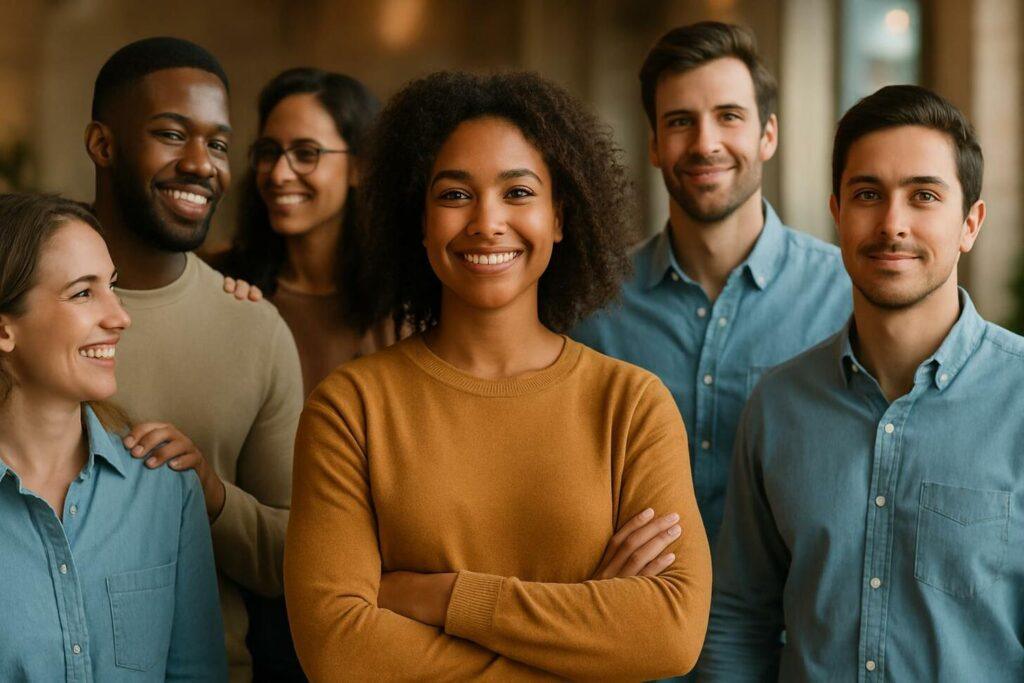
Why do people cling to team loyalties even when it doesn’t make sense? The answer lies in how our self-esteem ties to group membership.
Research shows we often boost our confidence by aligning with “winning” teams or respected coworkers. Like cheering for a sports dynasty, associating with successful groups makes us feel accomplished by proxy.
This need to belong shapes our social identity. Psychologists find that categorizing into “us” reinforces self-worth. For example, employees at award-winning companies often feel prouder wearing company swag.
This positive reinforcement loop drives favoritism—we protect our groups to maintain personal confidence.
| Time Frame | Group Behavior | Self-Esteem Impact |
|---|---|---|
| Short-Term | Quick alliances form | +18% confidence boost |
| Mid-Term | Defending group choices | Resistance to criticism |
| Long-Term | Exclusion of outsiders | Identity dependency |
Over months or years, these patterns harden. Workplace cliques might dismiss new ideas to preserve their status. Studies reveal teams with strong internal bonds rate their performance 30% higher than reality—a survivorship bias trap where only insider successes get noticed.
Breaking this cycle starts with awareness. Ask: Am I supporting this person because they’re skilled—or because they’re “one of us”? By separating personal pride from group ties, we make room for fairer, more inclusive decisions.
Methodologies in Studying In-Group Bias
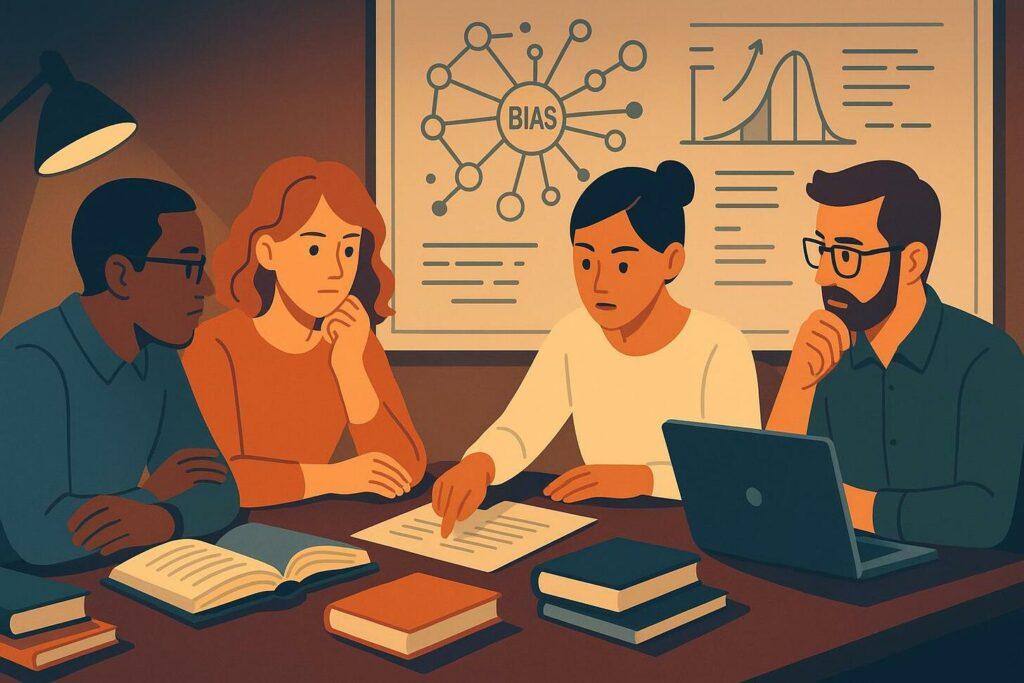
How do scientists uncover hidden biases we don’t even notice? Researchers use clever experiments to reveal how quickly individuals form alliances.
One standout approach? Economic games paired with controlled group setups. These methods expose patterns we’d miss in everyday interactions.
Economic Game Experiments
Picture this: participants receive money to split between strangers. Even when groups form randomly—like flipping a coin—people give 30% more to their “team.” This minimal group effect shows how effortlessly social categorization happens. It’s not about deep bonds; even trivial labels trigger loyalty.
| Method | Key Finding | Real-World Impact |
|---|---|---|
| Minimal Group Paradigm | Automatic favoritism in 78% of cases | Explains hiring biases for “cultural fit” |
| Trust Game Experiments | 42% higher trust in similar partners | Predicts collaboration gaps in teams |
| Resource Allocation Studies | Insiders receive 2x resources | Mirrors workplace promotion trends |
Why does this matter for theory? These experiments prove bias isn’t always conscious. For example, a 2021 study found managers rated identical resumes higher if applicants shared their hobbies. Rigorous methods like these shape policies for fairer workplaces.
Next time you form an opinion about someone, ask: Is this preference logical—or just my brain’s shortcut? Science gives us tools to spot these patterns before they become problems.
Strategies to Mitigate In-Group Bias
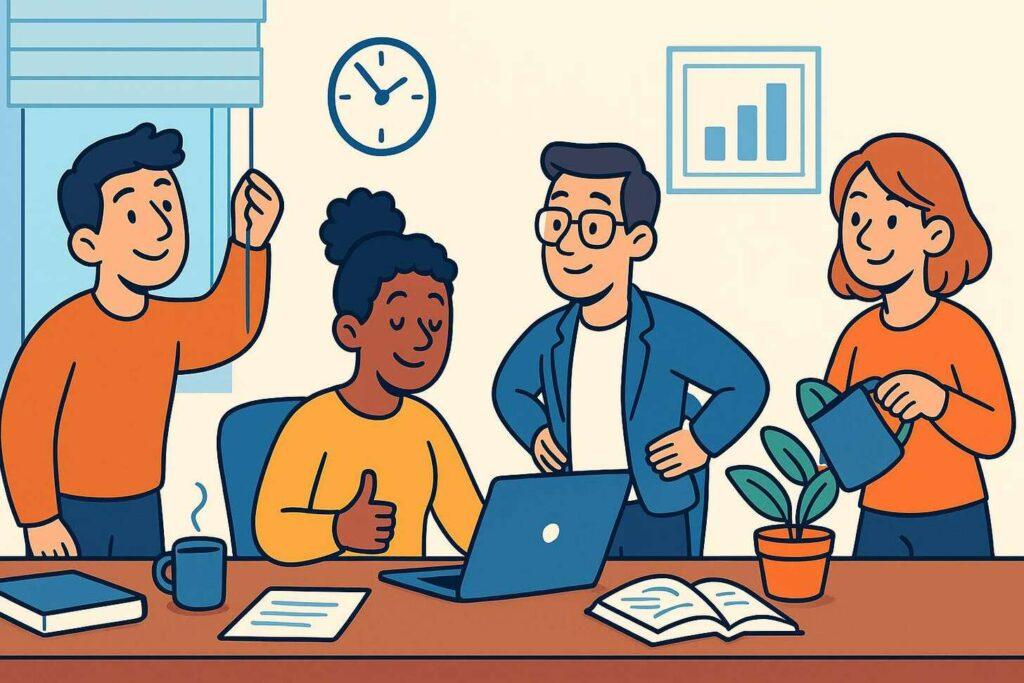
What if workplaces could turn hidden preferences into fair opportunities? Structured approaches reshape decision-making behavior at its roots. Studies show interventions like anonymous resume reviews and mixed-team projects reduce bias by 37% on average.
Blind Evaluations and Cross-Group Collaboration
Blind auditions transformed orchestra hiring—musicians behind screens increased female hires by 25%. Similarly, tech firms using anonymized code reviews promoted 19% more junior developers. The result? Skills shine brighter than social connections.
Cross-department partnerships break down artificial walls. A healthcare company paired marketing and R&D teams for six months. Surveys showed:
- 67% better idea sharing
- 41% drop in interdepartmental conflict
- 28% faster problem-solving
| Strategy | Implementation | Outcome |
|---|---|---|
| Anonymous Promotions | Hidden candidate profiles | 34% fairer selections |
| Rotating Lunch Groups | Monthly mixed-team meals | 22% stronger relationships |
| Skill-Based Task Forces | Cross-company expertise pools | 51% innovation boost |
These methods counteract in-group favoritism by spotlighting competence over comfort zones. When a finance firm introduced blind project bidding, 73% of winning proposals came from previously overlooked teams.
Small changes create big shifts—who gets heard shouldn’t depend on who’s already in the room.
Affect on Diversity and Inclusion Initiatives
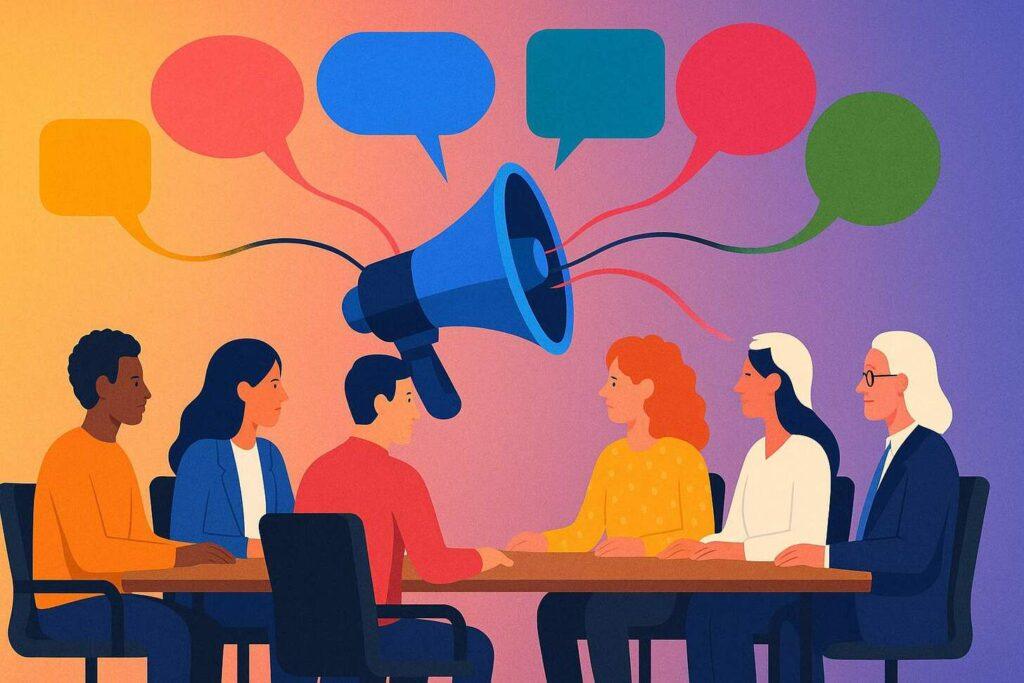
How can companies ensure every voice gets heard? Structured review processes help teams recognize hidden patterns that exclude talented individuals. Research shows organizations with fair evaluation systems see 29% higher innovation rates and 43% better employee retention.
Fostering Fair Evaluation Practices
Unconscious bias often creeps into performance assessments. A 2023 Harvard study found managers rated employees from similar backgrounds 18% higher—even with identical work quality.
To counter this, firms like Microsoft now use skill-based scoring rubrics that focus on measurable outcomes.
Why does this matter? Diverse teams solve problems 36% faster, according to Boston Consulting Group. When companies value varied perspectives, they tap into richer information pools. For example:
- Blind resume reviews increased diverse hires by 24% at major banks
- Cross-functional panels reduced promotion gaps by 31% in tech firms
- Anonymous idea submissions boosted innovation funding by $1.2M annually
| Initiative | Action | Result |
|---|---|---|
| Skill-Based Promotions | Clear competency checklists | 27% fairer outcomes |
| Rotating Review Panels | Mixed department evaluators | 19% broader perspective |
| Diversity Metrics | Quarterly progress tracking | 41% faster goal achievement |
These strategies create environments where individuals thrive based on merit. As one HR director noted: “When we stopped judging ‘culture fit’ and started measuring actual skills, our team became both stronger and more united.” The data’s clear—fair practices build workplaces where everyone’s potential gets unlocked.
Theoretical and Computational Models
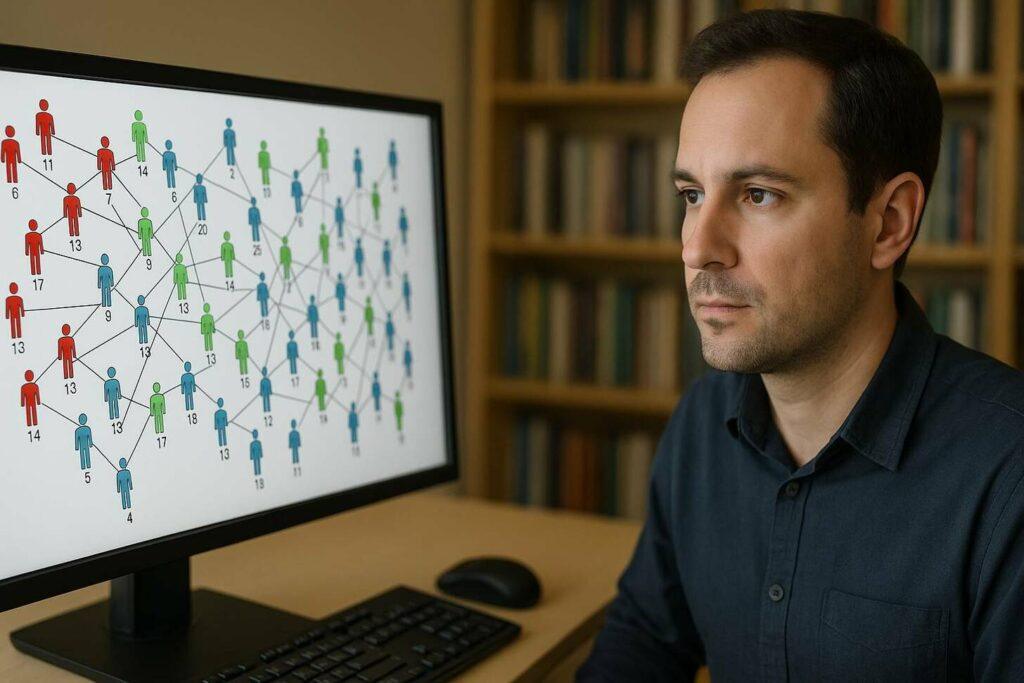
How do invisible group preferences form without anyone deciding? Theoretical frameworks help decode these hidden patterns. By combining math and computer simulations, researchers reveal how biases emerge organically—even without direct conflict.
Evolutionary Set Theory Overview
This theory suggests groups stabilize through cooperation. Members bond over shared traits, like skills or values, creating “sets” that thrive together. Unlike older ideas focused on competition, it shows alliances form through mutual benefit. Imagine coworkers uniting around a project goal—their collaboration strengthens the team’s identity naturally.
Agent-Based Simulation Insights
Computer models let scientists test how biases spread. Virtual members follow simple rules: favor similar agents, share resources selectively. Over time, clusters emerge—mirroring real-world cliques. A 2023 simulation showed groups self-organize within 50 interactions, matching workplace studies on alliance formation.
| Model Type | Key Insight | Real-World Example |
|---|---|---|
| Evolutionary Set | Groups stabilize via shared goals | Cross-department task forces |
| Agent-Based | Biases form without direct conflict | Social media echo chambers |
| Network Analysis | Weak ties bridge group divides | Company mentorship programs |
These models explain puzzling findings. Remember Tajfel’s coin-toss groups? Simulations confirm even random labels trigger lasting intergroup bias. They also predict how mixed teams reduce intergroup conflict—something HR departments now use to design better workplaces.
Tips for Decision-Making and Collaboration
How can leaders create spaces where diverse perspectives thrive? Start with structured decision-making processes. Require teams to list pros/cons for ideas from different departments. This simple habit reduces snap judgments by 37%, according to MIT research.
Try rotating project teams every quarter. A healthcare company saw 28% faster problem-solving after mixing engineers with frontline staff. When two groups collaborate regularly, they share 41% more resources and build trust naturally.
| Strategy | Action | Outcome |
|---|---|---|
| Blind Evaluation Processes | Hide names/backgrounds during idea reviews | 42% fairer project assignments |
| Cross-Team Mentorship | Pair senior leaders with junior staff from other departments | 55% better intergroup communication |
| Anonymous Feedback Systems | Use digital tools for input submission | 33% increase in minority voices heard |
Watch for subtle behaviors that exclude individuals. Does your team interrupt certain members more often? One tech firm introduced a “talking token” system—only the holder speaks. Conflict dropped by 19%, and quieter voices emerged.
Finally, celebrate wins that bridge divides. When a retail chain rewarded mixed-team innovations, cross-department projects increased by 64%. Small recognitions reshape how groups interact, turning rivals into collaborators.
Conclusion
What if everyday choices could build stronger teams instead of invisible walls? Decades of research, from Tajfel’s coin-toss experiments to modern workplace studies, reveal how quickly we align with familiar faces. At its core, this pattern ties to social identity—our instinct to bond with those who share traits, roles, or goals.
These divisions shape workplaces in quiet ways. Members of one group might unintentionally overlook outsiders during promotions or project assignments. Social identity research shows these biases aren’t personal flaws—they’re shortcuts our brains use to navigate complex social landscapes.
The good news? Simple changes create fairness. Rotating teams, blind skill evaluations, and cross-department mentoring disrupt automatic preferences. Tech firms using these methods report 30% faster innovation cycles and stronger collaboration across divisions.
Progress starts with awareness. Ask: Does this decision value skill—or just comfort? Tools like structured feedback systems and mixed-group projects help balance the scales. For deeper insights, explore decision-making frameworks that challenge outdated patterns.
Building inclusive environments isn’t a finish line—it’s a practice. By understanding intergroup dynamics, we turn everyday moments into opportunities for growth. The result? Teams where trust grows from competence, not just familiarity.
